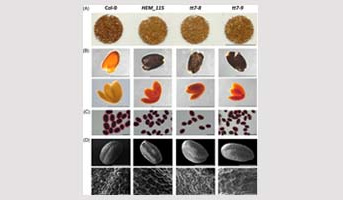An innovative screening for mutants affected in seed oil/protein allocation identifies a new transparent testa7 allele
In this study, an Arabidopsis thaliana homozygous EMS mutant library was screened for seed oil and protein content by near-infrared spectroscopy with the aim of identifying mutants with impaired oil-protein correlation. The mutant most affected in this correlation was found to be in the TRANSPARENT TESTA7 gene, which is involved in the flavonoid biosynthetic pathway. Analysis of different mutants in the flavonoid pathway revealed that the tt7 mutants were the only ones to show such a significant reduction in seed oil content, highlighting a phenotype never described before for the tt7 mutants and suggesting a specific role for TT7 in the interplay between the oil and flavonoid biosynthetic pathways. Untargeted metabolomic analysis allowed the identification of metabolic features that are highly accumulated and specific to tt7 seeds compared to the other genotypes and genetic analysis established that the accumulation of kaempferol-3-O-rhamnoside seems to be responsible for the seed oil reduction in tt7 mutants.
Many mutants impaired in seed oil/protein contents and correlation was detected studying a large homozygous EMS mutant population screened thanks to NIRS technics. These mutants are valuable resources for studying the regulation of seed compound relative accumulation.
Research developed at the Institute Jean-Pierre Bourgin for Plant Sciences in collaboration.
Back

Légend: TT7 is involved in seed coat differentiation. (A) Photographs showing mature seeds of Col-0, HEM_115, tt7-8 and tt7-9. Scale bars = 1 cm. (B) Mature seeds of Col-0, HEM_115, tt7-8 and tt7-9 were dissected, and seed coats and embryos were stained separately for starch using Lugol solution and observed under a binocular microscope. Scale bars = 500 μm. (C) Col-0, HEM_115, tt7-8 and tt7-9 seeds were gently mixed in water and ruthenium red (RR) was used to stain adherent pectin (pink). Scale bars 500 μm. (D) Scanning electron micrographs of whole seed and seed coat details of Col-0, HEM_115, tt7-8 and tt7-9. Asterisk indicates a columella. Scale bars = 300 μm for whole seeds and 50 μm for details.
IJPB Highlight
Référence:
Lécureuil A, Corso M, Boutet S, Le Gall S, Niñoles R, Gadea J, Guerche P, Sophie Jasinski S. Innovative screening for mutants affected in seed oil/protein allocation identifies TRANSPARENT TESTA7 as a regulator of oil accumulation. The Plant Journal 2025.
doi : https://doi.org/10.1111/tpj.70269
Contact: Sophie Jasinski, contact
IJPB teams:
> "Strigolactones and Allelochemicals Signaling" SAS
> "DNA Repair and Genome Engineering" DRAGON
> "Seed - Development, Regulation, and Metabolism" SEED-DREAM
> "The Plant Observatory - Chemistry/Metabolism" plateform PO-Chem